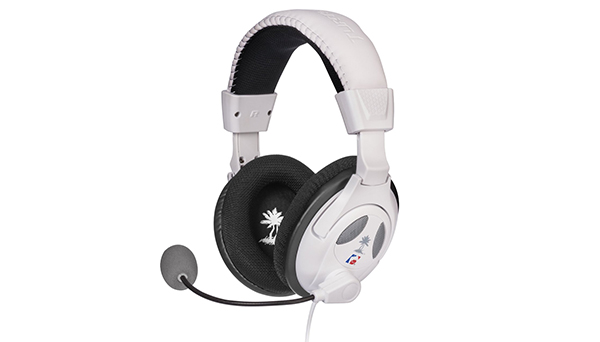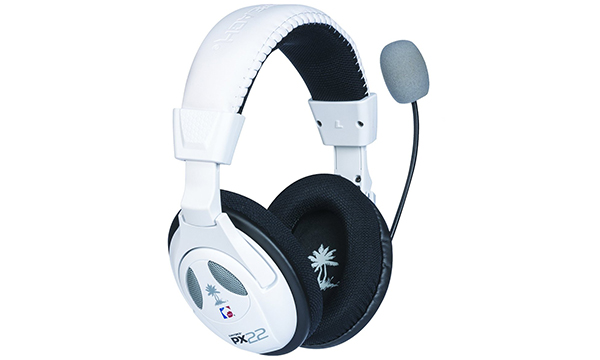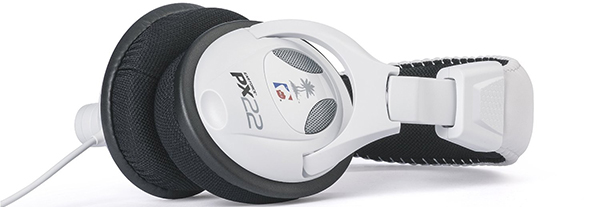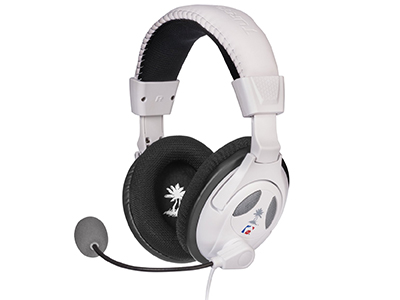Tom's Guide Verdict
For competitive and single-player gamers alike, the Turtle Beach Ear Force PX22 is a capable, attractive and inspired choice.
Pros
- +
Good sound for games and music
- +
Comfortable ear cups
- +
Works with mobile devices and handhelds
- +
Innovative microphone
Cons
- -
Smartphone calls sound muddy
Why you can trust Tom's Guide
Gaming peripherals that combine simplicity, functionality and affordability are a bit like people who can rattle off all 50 states: cool when you can find them, but not that common. The Turtle Beach Ear Force PX22 ($80), however, is a gaming headset that sounds great, feels comfortable, connects with just about any system and costs less than any of its competitors. For competitive gamers, single-player aficionados or just those who don't want to keep their significant others up late at night, the Ear Force PX22 is a capable, attractive and inspired choice.
Design
If you've come across the Turtle Beach Ear Force X12, the PX22 will not appear very different. This peripheral is available in either black and white (there are no cool camo patterns this time around, unfortunately), and has a pretty no-frills design. It has large, padded ear cups, a padded headband and a ridiculously long cord — good for consoles and living room setups, potentially overkill for gaming nooks.
MORE: Best Gaming Headsets
As with the X12, the PX22's microphone deserves special mention — I've never seen another like it. The microphone is located at the end of a flexible metal arm, and the arm itself is attached to a rotatable nub. Most gaming headset mics are either rotatable or bendable, but not both. This design, unique to Turtle Beach headsets, gives users an unprecedented level of control over mic placement.

The headset also includes an inline amplifier, which controls features like treble and bass levels, mic settings and phone connectivity. It's small and mostly unobtrusive, although it does require USB power to function. The good news is that, unlike the Ear Force X12, USB power is optional. If you'd rather plug the headset into a mobile device or handheld console, you can simply unplug the main audio jack from the inline adapter. It's an elegant solution to a notable flaw in the less expensive model.
Comfort
Like the Ear Force X12, the PX22 is comfortable to wear for hours on end. There's plenty of padding, and the ear cups are both big and soft enough to fit just about any head size, even if you have lots of hair or thick glasses. The ear cups swivel, and the headband has a lot of give. Even if you have to tinker for a bit, you should be able to find something that exerts just enough pressure to stay in one place without pressing down too hard or causing pain.
I handed the Ear Force PX22 off to a co-worker, who had a similar experience. He found them easy to wear, and told me that he could envision himself wearing them all day without any ill effects.
Gaming Performance
To test how well the Ear Force PX22 functions in-game, I took some time to play both Titanfall and Assassin's Creed Unity while wearing it. This gave me a pretty good idea of how it sounded for both competitive action titles and games where ambient noise, dialogue and orchestral soundtracks take center stage.

The peripheral performed well for both games, especially with the bass turned up. My firefight in Titanfall sounded immersive, replete with mech suits clanking at each other in frenzied melees and futuristic soldiers clambering over crumbling walls. In Assassin's Creed Unity, it was easy to make out the conversations of French townsfolk and the guttural gurgles of guards as they succumbed to Arno's hidden blade.
My only criticism — if you can call it that — was that nothing about the sound really set it apart from its competitors. The PX22 always sounds good, and often sounds great, but I couldn't point to any singular feature that really sets it apart from its peers.
Features
The Ear Force PX22 does not possess any software, but its inline adapter fills many of the same roles, and in a much more straightforward way. The adapter itself is a small white box with five dials: bass, treble, chat volume, game volume and inline mic volume (how well you can hear your own voice). You can also mute the mic, select whether to hear your own voice from the mic, or gear the mic toward phone calls.
Although the Ear Force PX22 does not feature Bluetooth phone connectivity, like the Roccat Kave XTD, you can plug it into your phone manually and have conversations without having to take your hands away from your keyboard and mouse. You can also use the inline adapter to hook the headset into Xbox and PlayStation consoles.

Having grappled with a lot of unintuitive headset software, I much prefer the Ear Force PX22's approach. The inline adapter is simple, intuitive and takes almost no time to learn and manipulate. Whether I was listening to music or playing a game, I could always take a few seconds to tweak treble and bass levels. It's not quite as deep as software that gives you 10 different equalization options, but it's much more user-friendly.
MORE: Best Gaming Desktops
The mic is also a strong one. When talking with a co-worker via Skype, he informed me that my voice was crystal clear. I found it easy to adjust the mic to a comfortable position, and we talked without any interruptions or loss of clarity. The only caveat is that the mic didn't sound quite as good when I used it on the phone setting. We were able to talk, but he said that I did not sound as clear when channeled through the smartphone.
Music Performance
Like the Ear Force X12, the PX22 is one of the better headsets I've come across for playing music. Especially with the inline adapter to fine-tune bass and treble options, every genre of music I listened to sounded considerably better than it did on most peripherals I've tested.
I tried the Ear Force PX22 with music from G.F. Handel, Flogging Molly and Old Crow Medicine Show to get a good mix of genres, and it sounded good all around, although I did have to play with the bass and treble to get the best balance each time. By default, rock music sounded a little distant, but turning up the treble slightly improved the overall fidelity, and turning up the bass made sure that the low notes didn't get lost.

While the Ear Force PX22's music output can't compete with that of a fancy headset (I usually use a $200 Sennheiser HD 25-1 II), it's a perfectly respectable choice for casual listeners. If you pick up the PX22, you probably won't need two separate headsets for games and music, unless you're a professional musician or a hardcore audiophile.
Bottom Line
When I finished my first round of tests with the Ear Force PX22, I thought, "This feels like a $150 headset." Imagine my surprise and delight, then, when I learned that it retails for about half that amount. The Ear Force PX22 is intuitive, comfortable and loaded with more options than you might expect for the price. Turtle Beach has a reputation for making the best headsets in the business, and the Ear Force PX22 demonstrates why it's well-earned.
Marshall Honorof is a Senior Writer for Tom's Guide. Contact him at mhonorof@tomsguide.com. Follow him @marshallhonorof. Follow us @tomsguide, on Facebook and on Google+.
Marshall Honorof is a senior editor for Tom's Guide, overseeing the site's coverage of gaming hardware and software. He comes from a science writing background, having studied paleomammalogy, biological anthropology, and the history of science and technology. After hours, you can find him practicing taekwondo or doing deep dives on classic sci-fi.


